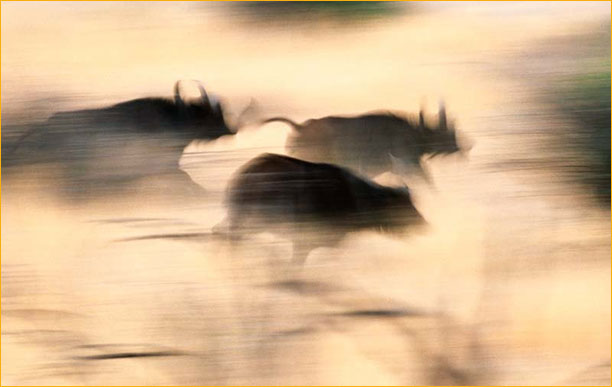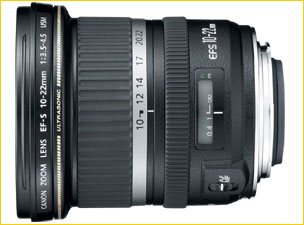
Since the first APS-C sized imagers appeared in DSLRs a few years ago, photographers have struggled with not having lenses which can provide super-wide angle coverage. With a 1.6X factor, (on Canon DSLRs, at least), a 16mm focal length, like that of Canon’s 16-35mm zoom, becomes just 25mm at the wide end.
Recently a number of even wider-angle lenses have become available, and the latest of this batch, at least for owners of the Canon 20D and Rebel, is the recently announcedCanon EF-S 10-22mm f/3.5-4.5 USM. This lens is the equivalent on a reduced frame camera of a 16-35mm in full-frame terms.
Keep in mind though that the 10-22mm is anEF-Slens, which means that its designed to only cover the reduced frame size of these cameras. The lens will therefore not work with nor fit on any previous Canon body, though it is likely to fit on all future APS-C sized bodies that have the required lens mount. (The Canon D30, D60 and 10D do not have the new EF-S compatible lens mount flange. They can not be retrofitted, and though there is a kludged solution floating around the net, it can not be recommended, as it endangers the camera’s mirror hitting the lens’ rear element.)
As for whether this lens is good or not (and as we’ll see , it’s very good), a buyer needs to decide if an investment in a lens that will not work on a full-frame camera at some point down the road is a good idea. This is not an inexpensive lens, at about USD $800.
In the Field
This lens is small. light and solidly built. Sometimes Canon’s non-L series lenses can feel a bit cheap, but not this one. Focus is as fast as ever due to the USM motor, and manually focusing, if you’re so inclined, is similarly smooth. The lens is in the current Canon idiom, and there is little to fault about it with regard to either fit or finish.
The lens features a Super UD glass element as well as three aspherical elements The filter size is 77mm, though care will need to be taken with filters at the widest focal length settings.
A Comparison
During the week that I had it for testing I did a number of comparisons with the Sigma 12-24mm zoom, which was also under test at the time. While this lens doesn’t go as wide as the Canon, it does cover full-frame, and therefore is of interest to those that still shoot film, or who have a 1Ds series camera.

It’s not my intention to do a full or comprehensive comparison between these two, and I’ll be publishing a test of the Sigma at a later date. But the crop below speaks for itself. The Canon lens, at its widest setting at last, is head and shoulders better than the Sigma, at least as far as resolution goes.

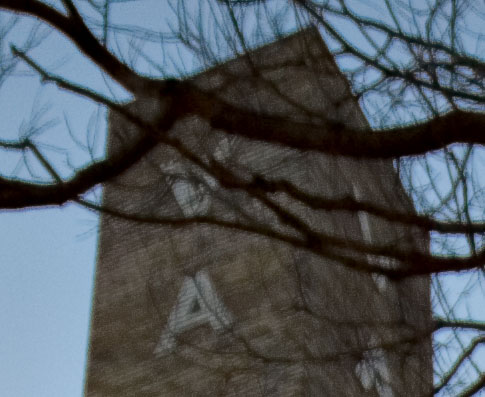
Gripes
Not too many. The main one is that the lens does not ship with its custom lens shade, the EW-83E. I know that L series lenses do, and non-L series do not. But, I regard this as a poor policy on Canon’s part. A lens shade is a must for any serious photographer, both in terms of protecting the image from non-image-forming light, and also errant finger prints, or worse. Most dealers don’t stock these specialized shades, and it’s a hassle for photographers to get them. Come on Canon. Just include the damn thing with all your lenses.
In The Lab
An Optical Analysis Using

About The Tests
As you can see from theDxO Tutorialthere are a large number of charts and text graphs produced for each of the tests —Distortion & Chromatic Aberration,Vignetting, andBlur. (Noise is excluded here because it is only relevant to testing sensors). A more comprehensive test would have to be done at all available apertures, all available ISO speeds, and at a large cross-section of focal lengths (in the case of zoom lenses). This would not only take an inordinately large amount of time to conduct, but would take up far to much space here and likely not be of much interest.
In the case of zoom lenses this test is done at a mid-position in the lens’ focal length range. Where appropriate I also post data for other F stops, ISO ratings and in the case of zooms a selection of focal length, including the widest and longest. In my comments to each section I draw attention to extremes of performance, such as maximum vignetting, greatest and least noise, etc.
To jump directly to the definition and tutorial for a specific test click on the DC, V or B logos.
Distortion and Chromatic Aberration
Canon EF -S 10-22mm f/3.5-4.5 USM @ ISO 100.
Focal Length = 15mm
Camera used: Canon 20D
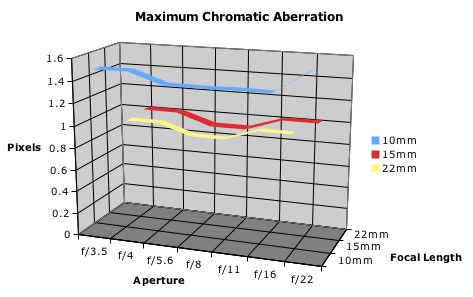
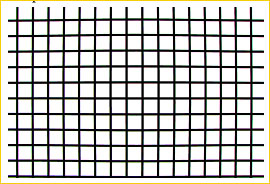
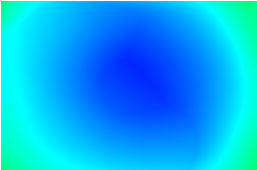 |
| Absolute CA Map |
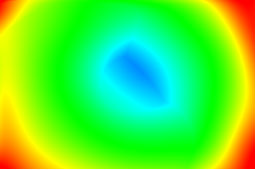 |
| Relative CA Map |


Distortion Distortion
@ 10mm
5X Magnification
Distortion Distortion
@ 22mm
5X magnification
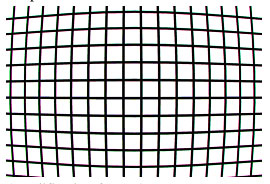
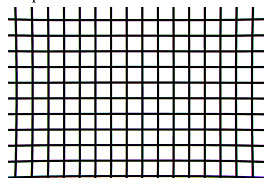
Observation
Chromatic aberration is moderate for an ultra-wide angle lens. Not the worst, but certainly not the best. In real world shooting tests though I never encountered any significant CA. In terms of distortion though this lens measured very well. There is moderate barrel distortion at 10mm, a negligible amount at 15mm, and only a tiny amount of pincushion distortion at 22mm. Overall, exemplary performance in this measure.
Vignetting
Due to a technical glitch when conducting my tests vignetting results are not available.
Visually, vignetting with this lens is typical of ultra-wide zooms.Blur
Observation
This is an extremely sharp lens, at all three tested focal lengths. Optimum apertures are f/5.6 and f/8. Smaller than that diffraction effects start to degrade performance.
Remember that +1 BxU is equal to oneBlur-Morefunction in Photoshop. To see for yourself what this represents in subjective sharpness difference, load any reasonably sharp image into Photoshop and then apply Blur More. So if two lenses are 2 BxU apart, you need to do it twice to evaluate that difference.
__________________________________________________________
Conclusion
The numbers tell a positive story, but more importantly, this lens is capable of producing some very fine results in terms of prints. I wouldn’t hesitate to use the Canon 10-22mm for any professional application.
The real conundrum is whether an investment in a lens such as this, which is limited to Canon bodies with 1.6X factor APS size sensors, makes sense. If you don’t expect that you’ll ever buy a 1.3X format camera like the 1D Mark II, or a full frame camera like the 1Ds Mark II, or a film body, or a future Canon with a larger imaging chip, then sure – if your work needs this kind of coverage, this lens makes sense. It is probably the highest quality super-wide zoom that one can currently buy for a Canon DSLR of this format.
But, if you believe that there will be a larger chipped Canon camera in your future, then this lens is a dubious long-term purchase as it will neither fit not function on any camera with a sensor larger than 1.6X magnification.
As the saying goes –you pay your money, and you take your choice.
__________________________________________________________
Update:
Since this review first appeared several people have written and sent in samples, saying that their Sigma 12-24mm lenses are not as bad as the one that I used in the above comparison.
A couple of thoughts – first; these samples shots were taken tripod mounted, so there is no chance that the problem seen was caused by vibration.
Secondly, when I review products, unless there is an obvious failure or malfunction, I have to work on the assumption that the sample that I am testing is representative of what the typical purchaser will find. I have neither the time, nor inclination, nor ability to tests multiple samples of any lens or other product, just as the typical consumer doesn’t have that luxury. I am also unable to guess whether a poorly performing lens is doing so because it’s simply a bad design, or if I have a bad sample.
Regrettably, one of the common criticisms of Sigma is inconsistent quality control. This may be what’s at work here, though it may not. I can’t say. But the lens that I tested was off a dealers shelf, and therefore typical of what any consumer might expect to buy. Whether it is better or worse than average I can’t say. But as always,caveat emptor– whatever the brand.
Just a quick note supporting what you had mentioned about Sigma quality control. I purchased a Sigma 12-24mm zoom this past summer, and took some test photos to compare it with Sigma 15-30mm and Canon 20-35mm zooms I already owned. The sharpness of the 12-24mm zoom was horrible by comparison, especially when I got away from the center of the photo. In fact, it was so bad that I went out and reshot the photos I had taken with it just to make sure I hadn’t done something wrong.
After discussing this with both Sigma technical support and the company I purchased from (B&H Photo), they both agreed that my results didn’t align with what they expected from this lens, so I arranged a lens exchange. The second 12-24mm lens was a night & day difference from the first one in sharpness, and compared well with the other two zooms. As a result of this experience, I now test all new lenses I get to sanity check that they are working properly.
Based on my experience, I will lay odds that you got a defective lens much like I did.
– Jeff
_________
Thanks for this test. I think you take pictures with “my” Sigma, there were the same results. I have testet two of them (1Ds and 10D) and bring them back to my dealer.
– Theo
__________________________________________________________





